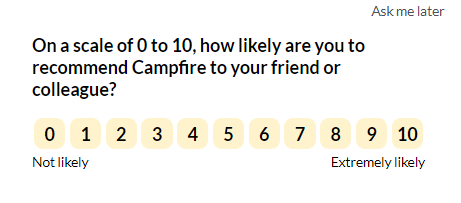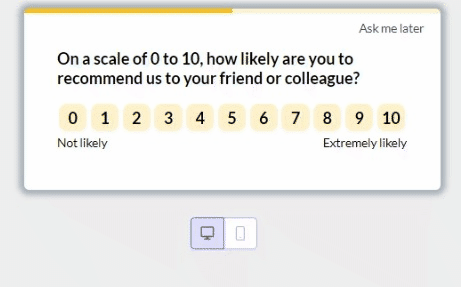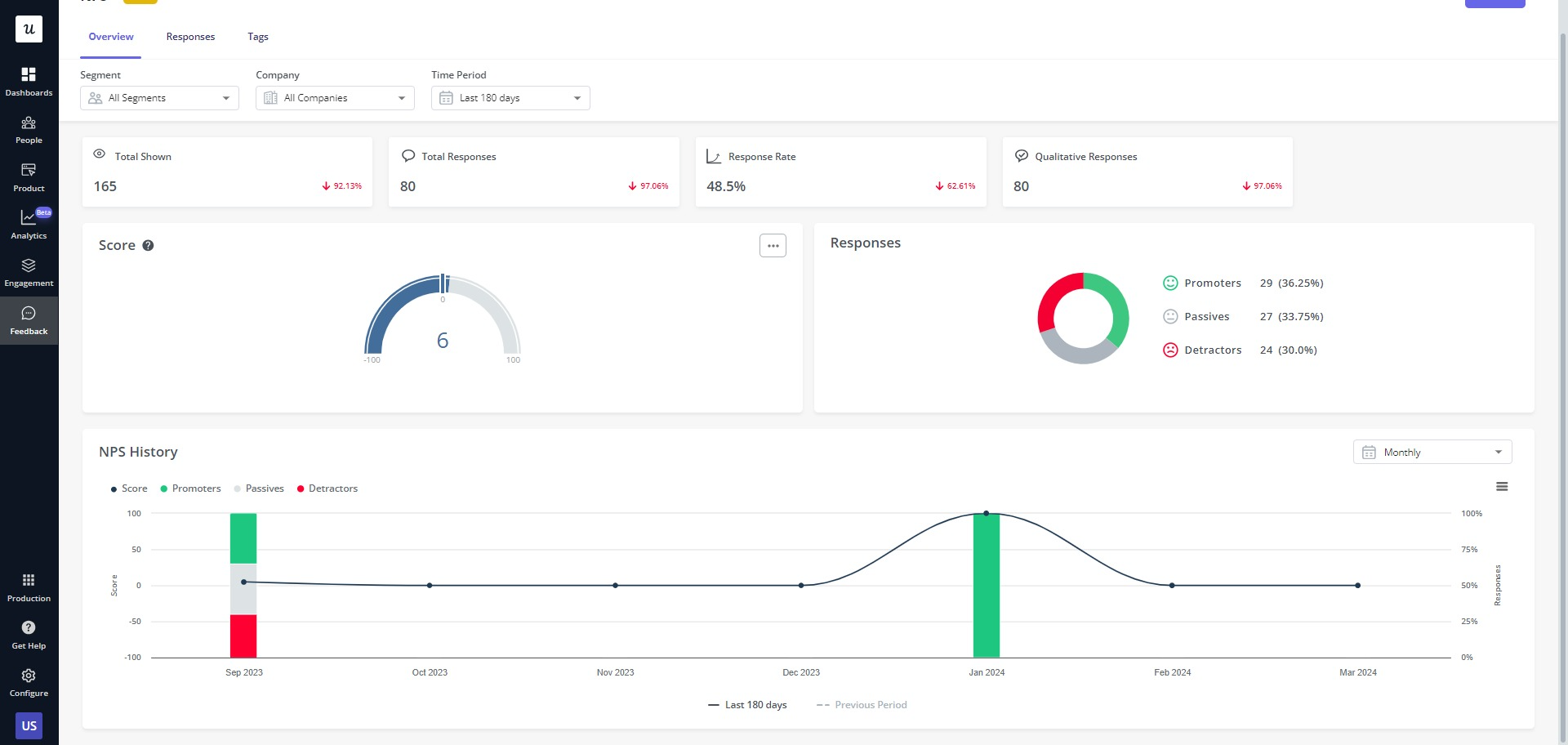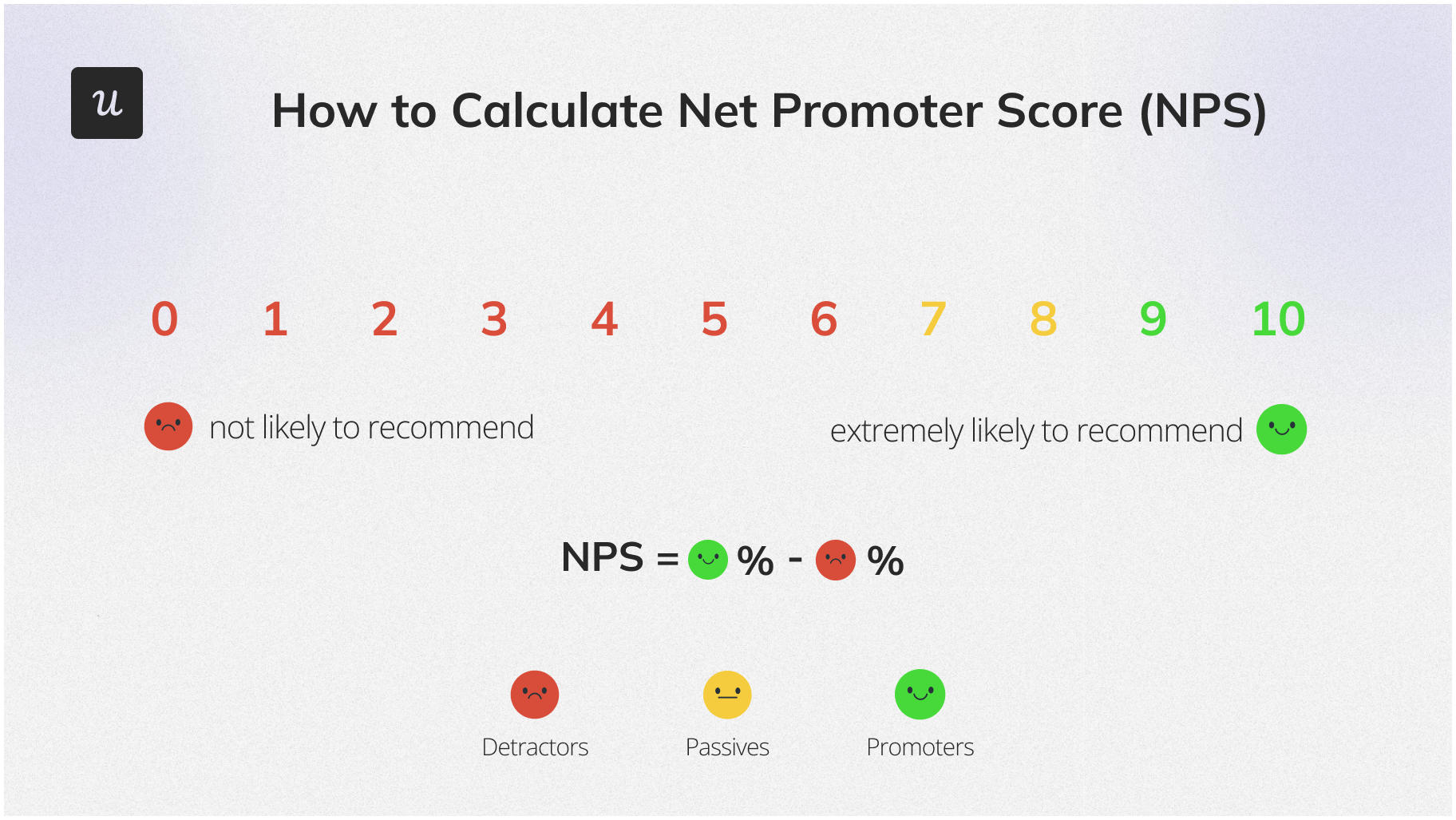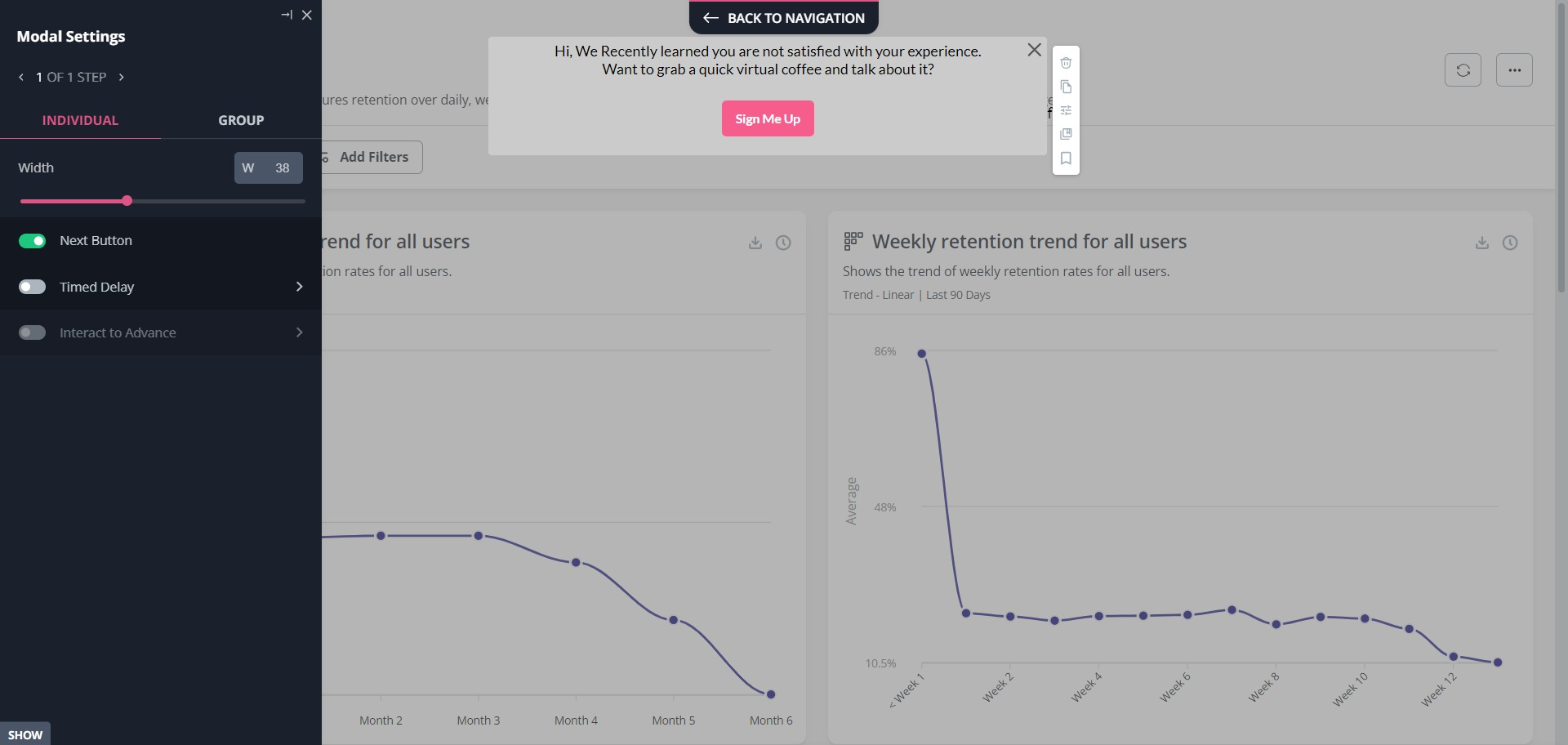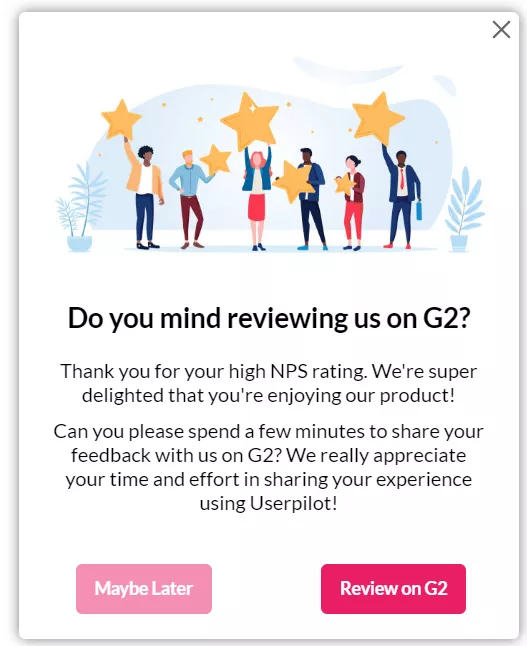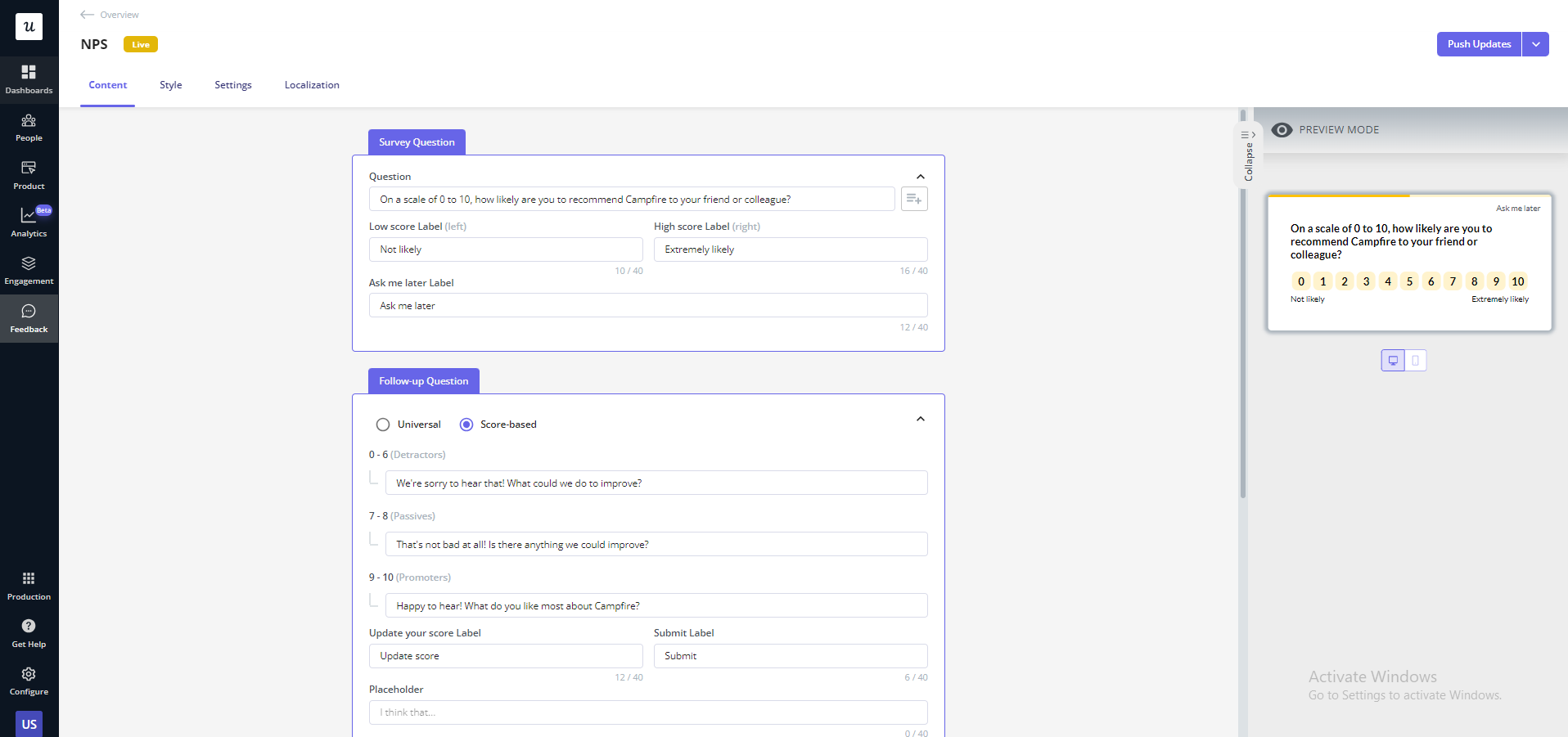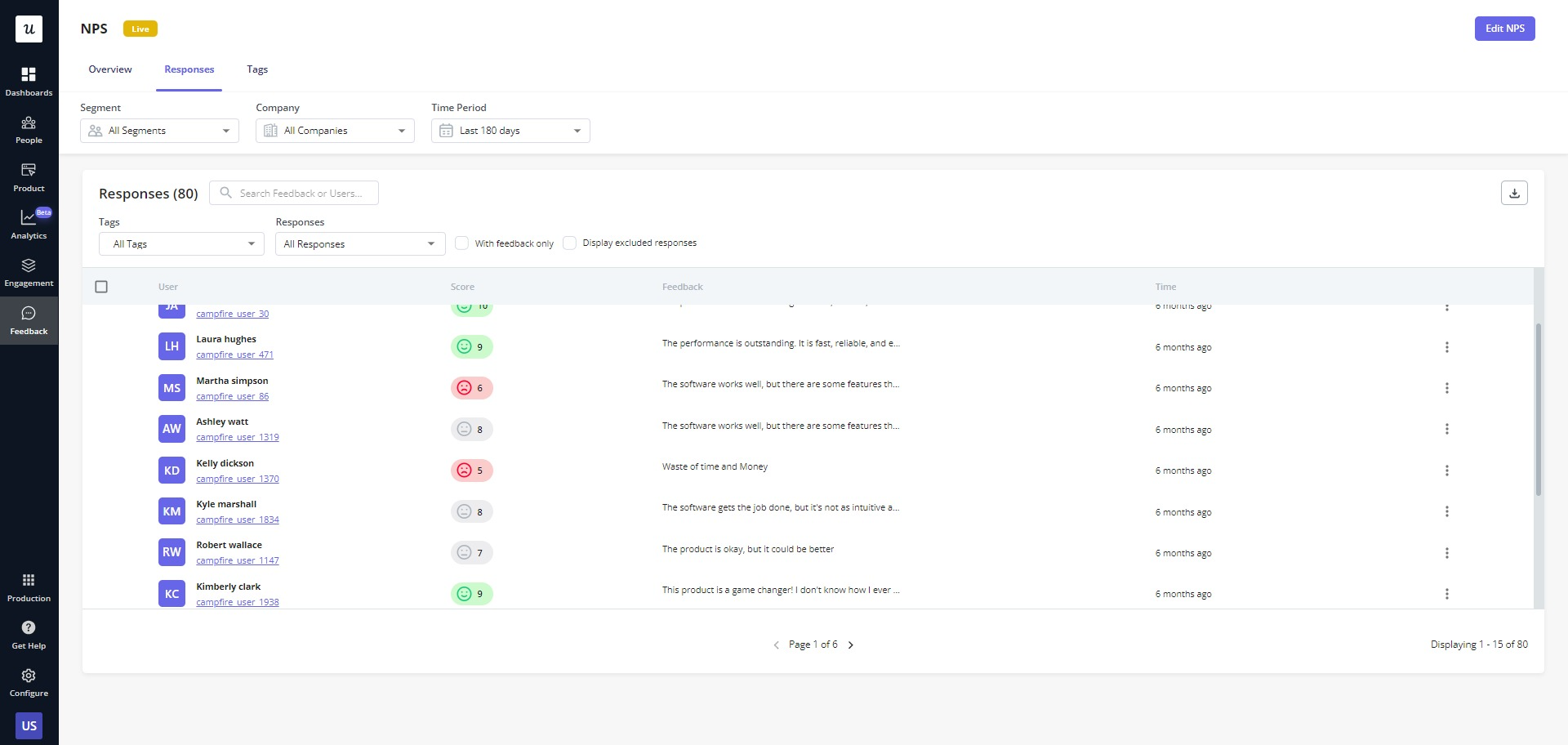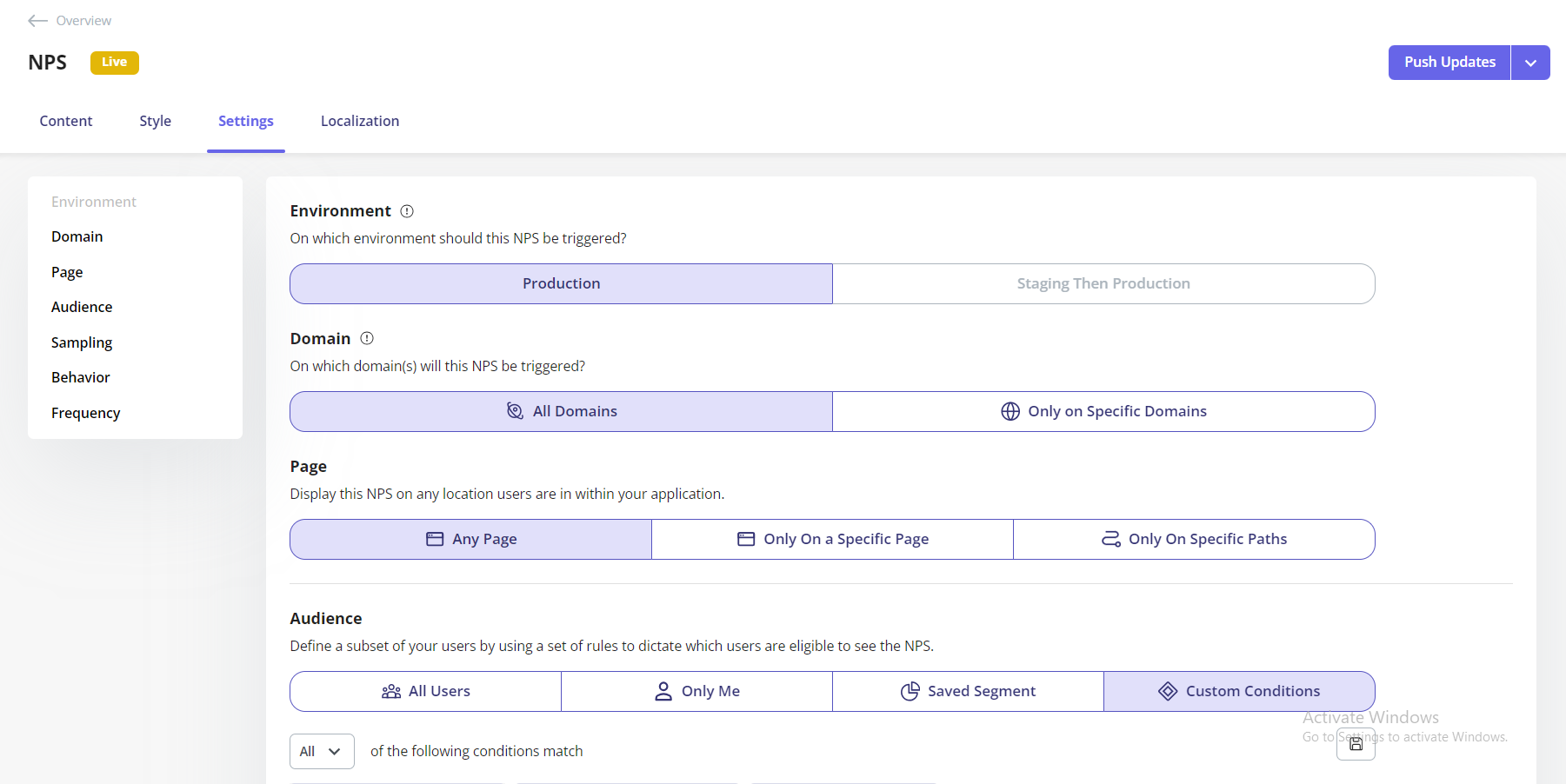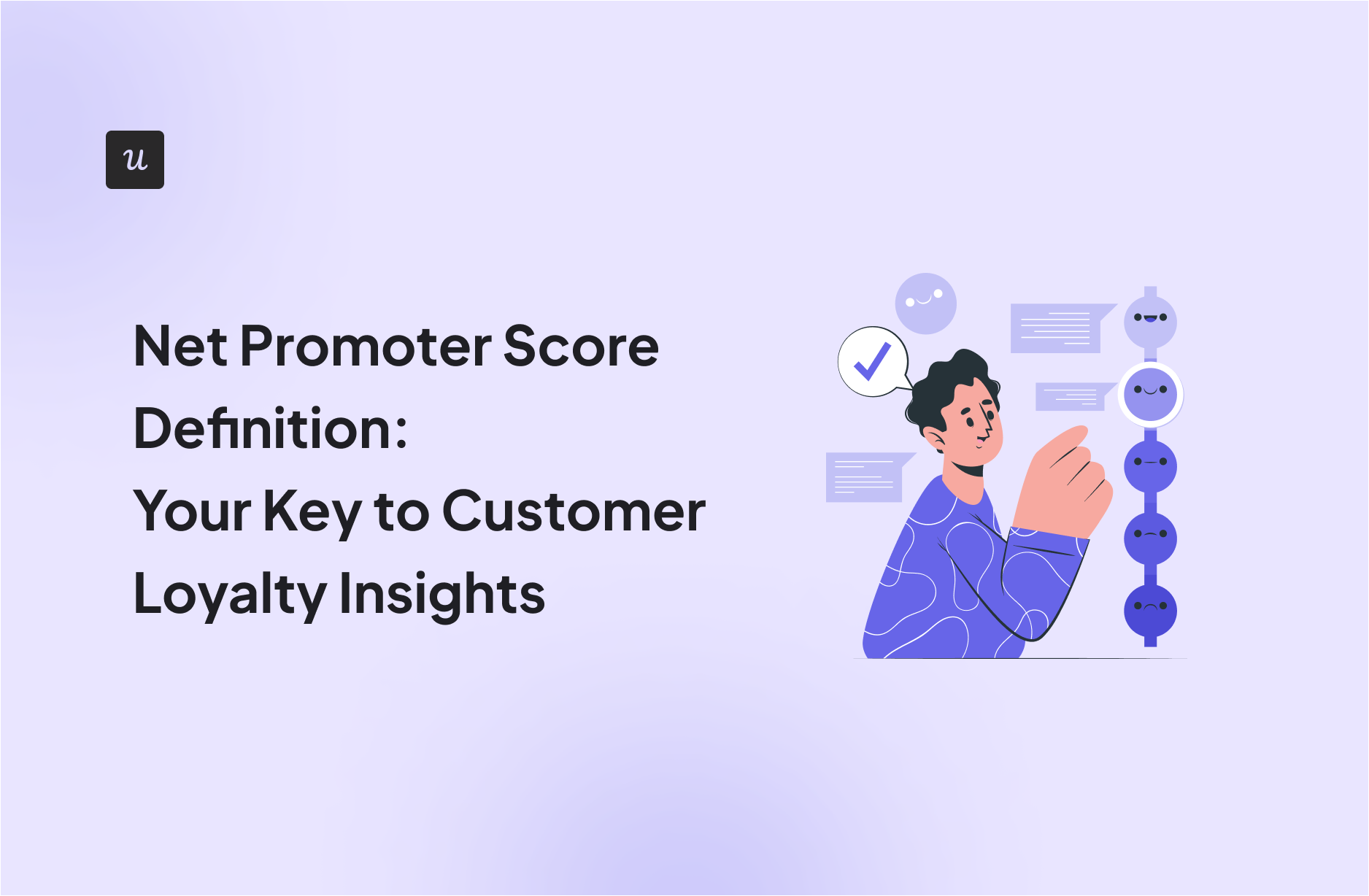
Ever wondered how likely your customers are to recommend your business? That’s where Net Promoter Score (NPS) comes into play.
This measurement is more than a statistic—it’s a mirror reflecting your customer’s loyalty and the health of your customer relations. Dive into the Net Promoter Score definition to discover mirror customer sentiment and how it can help redefine your business strategy.
What is the core question for a Net Promoter Score definition survey?
A customer who gives a score of 0-6 is known as a…
Which group’s score is NOT actively used in the main NPS calculation?
You’ve got the basics of the Net Promoter Score definition down!
Ready to see how you can create, send, and analyze NPS surveys to boost customer loyalty without writing any code?
Try Userpilot Now
See Why 1,000+ Teams Choose Userpilot

What is the Net Promoter Score (NPS)?
At the core of strategies focused on customer satisfaction, the Net Promoter Score is widely used for measuring customer loyalty and customer satisfaction with your SaaS product.
NPS assesses how customers feel by posing one direct question: “On a scale from 0 to 10, how likely are you to recommend our company’s product or service?”
Through surveys based on the Net Promoter Score system, companies can not only track but also increase the number of loyal customers by examining the data gathered from these Net Promoter Scores.
Net Promoter Score surveys help shine a light on what’s working well and potential improvements. Leveraging customer feedback received via this method paves the way for SaaS companies to strengthen bonds with clients.
What distinguishes NPS as particularly impactful?
Its uniqueness comes from transcending beyond mere snapshots of client happiness at certain moments. It delves into measuring ongoing devotion, which better captures if existing customers will endorse your offerings over time. This places it amongst the critical metrics used by any discernible entity aimed at realizing growth through sustained client relations.
Importance of NPS for SaaS Businesses
In the realm of SaaS, companies that truly understand and cater to their customer’s needs and preferences are more likely to succeed.
The Net Promoter Score survey plays a pivotal role in this by identifying the most satisfied customers who are likely to advocate for your brand. This advocacy can lead to an enhanced reputation and drive growth through word-of-mouth.
Here are the key benefits of NPS:
- Gauge Customer Loyalty: By pinpointing satisfied customers, NPS helps in nurturing and recognizing those who are more likely to be loyal advocates of your service. It also helps restore customer relationships with dissatisfied customers and with time convert them into loyal ones.
- Enhance Customer Satisfaction: With NPS response tagging, you can easily identify the reasons behind customer dissatisfaction and use in-app experiences to proactively improve satisfaction among your users.
- Increase Customer Retention: Utilize the actionable insights gained from high NPS ratings to bolster customer retention strategies. Engage with these satisfied customers to understand what keeps them coming back, and implement these best practices across your service offerings to maintain a robust and loyal customer base.
- Minimize Customer Churn: By integrating NPS feedback across various touchpoints, you can swiftly address issues that may otherwise lead to customer attrition.
Furthermore, it serves as a guiding force for entire businesses by fostering strategies deeply rooted in understanding and prioritizing customer needs—proving itself to be an essential measure and a framework shaping corporate progress and success.
Net Promoter System: Question, dashboard, categories
Now we will go over the essentials of an NPS analysis, starting with the core question that measures customer loyalty, the dashboard that visualizes the data, and the categorization of customers into promoters, passives, and detractors—each playing a unique role in your company’s growth.
The NPS Question
The essence of an NPS survey is encapsulated in the pivotal NPS question, “How likely are you to recommend our product/service to a friend or colleague?”
Customers respond on a scale from 0 (not at all likely) to 10 (extremely likely), reflecting their brand loyalty and propensity towards endorsing your business.
A best practice would be to add a follow-up question based on the score they choose and gain actionable insights.
By asking this simple yet powerful question, customers can efficiently convey their feelings about your product or service.
NPS Dashboard
A visual representation of Net Promoter Score data comes through an NPS Dashboard, which serves as a reflection of customer loyalty and contentment levels.
Here are the most crucial NPS data points to track with an NPS dashboard:
- Monthly/Weekly/Version-wise Net Promoter Score: Monitoring the NPS at regular intervals or after specific updates can reveal trends and the impact of changes on customer loyalty.
- Global NPS Score: A collective measure of customer loyalty across all regions, providing an overarching view of brand advocacy.
- Data Organized According to the NPS Categories: Detailed breakdowns of promoters, passives, and detractors help identify the proportion of each and guide targeted strategies.
- Total Number of Users Who Participated in an NPS Survey: Indicates the level of engagement and represents the sample size for the NPS data, which can affect its reliability.
- Comparison of the Net Promoter Score with the Time Spent on Your Website or App: Correlating NPS with user engagement metrics to assess the relationship between satisfaction and usage patterns.
- NPS by Customer Segments: Differentiating NPS scores by specific customer segments (e.g., by product line, subscription type) to pinpoint areas of strength and opportunities for improvement.
- NPS Feedback Participation Compared with the Number of Daily Active Users (DAUs): Understanding how representative the NPS feedback is with the overall active user base.
NPS Categories: Promoters, Passives, and Detractors
The Net Promoter Score categorizes customers into three segments according to their scores: Promoters, Passives, and Detractors. Each group plays a distinct role in influencing the company’s image and growth prospects.
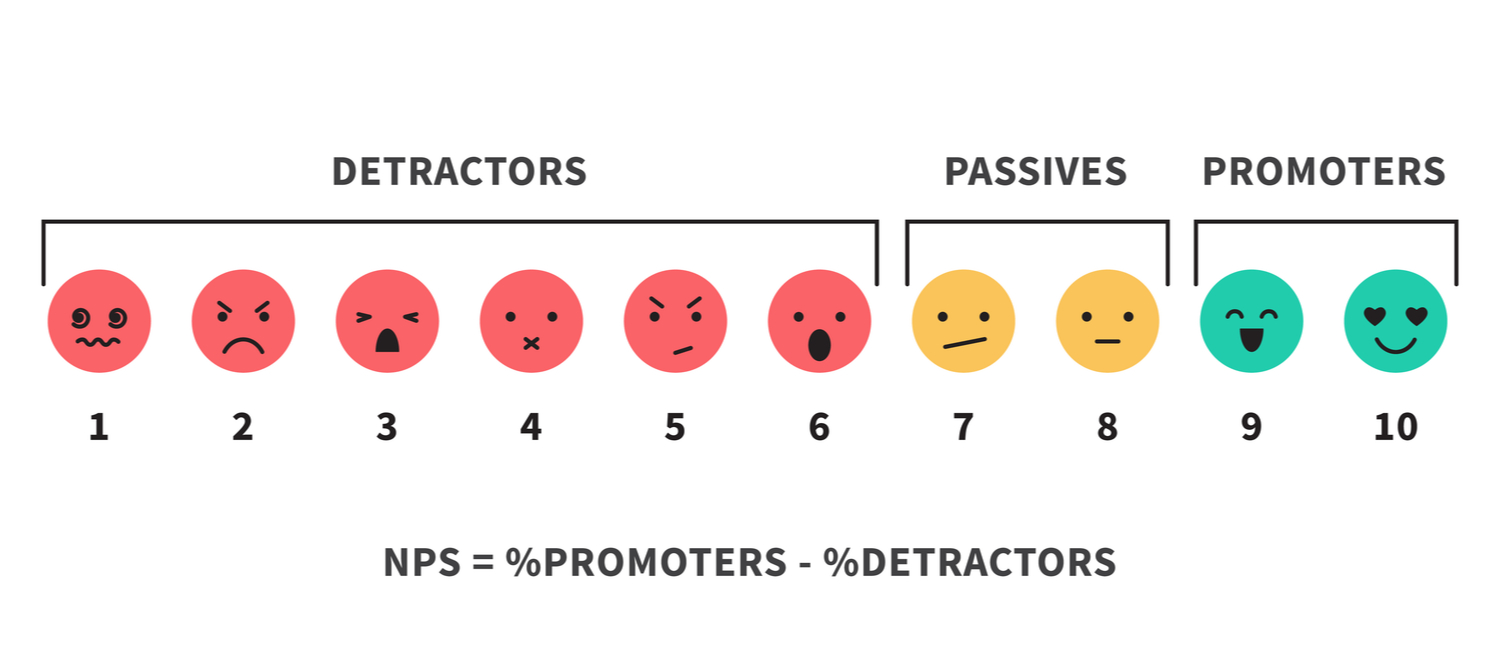
Promoters are those who respond to the NPS question with a score of 9-10. They act as ardent supporters of your brand, often recommending it to others, thereby boosting your online presence and attracting new business through referrals—key contributors toward achieving a favorable Net Promoter Score.
Customers giving a score of 7-8 on the NPS question fall into the passive category. These individuals typically don’t spread negative word about your brand but also do not actively promote it.
Detractors comprise unhappy customers issuing an NPS rating between 0-6. This segment has the capacity for harmful implications by disseminating negative word-of-mouth that can tarnish your brand’s public perception.
Grasping these classifications is essential for capitalizing on promoters’ advocacy while addressing consumer concerns in efforts to amplify overall customer satisfaction levels.
Net Promoter Score calculation
The calculation of the Net Promoter Score is straightforward yet impactful.
To calculate the Net Promoter Score, one deducts the percentage of detractors (customers who rate between 0 and 6) from the percentage of promoters (customers rating at a high level of 9 or 10). As a result, this measure can vary widely from -100—meaning every customer is a detractor—to +100 where everyone is identified as a promoter.
It’s noteworthy that those customers giving passive scores, which are ratings falling within the range of 7 to 8, don’t actively influence the final NPS score calculation. Such neutral responses are excluded when determining your final Net Promoter Score. By focusing solely on detractors and promoters in its computation method, NPS becomes an explicit indicator capturing both satisfaction and loyalty among consumers toward your brand.
What is a good Net Promoter Score in SaaS?
Understanding what constitutes a good Net Promoter Score (NPS) in the SaaS industry involves looking at both absolute and relative benchmarks.
Bain & Company, the originators of the NPS system, suggest that an NPS above 0 indicates positive customer sentiment, while a score above 20 is considered favorable, and anything over 50 is excellent. Achieving an NPS above 80 places a company in the highest echelon of customer loyalty and satisfaction.
In the absolute sense, an NPS over 50 is generally seen as an indicator of a strong customer loyalty foundation, transcending industry boundaries.
However, the relative NPS method provides a more nuanced perspective by comparing your score against those of your direct competitors within the same industry. Depending on the specific market dynamics, an above-average NPS could range from 0 to 40 or higher.
How and when to implement NPS Surveys
Understanding when to implement Net Promoter Score (NPS) surveys is crucial for capturing accurate measures of customer loyalty and satisfaction.
NPS surveys can be a powerful tool for gathering feedback and should be strategically timed to maximize response rates and relevance of the data collected.
- Periodically to Measure Customer Loyalty: Routine NPS surveys, such as quarterly or bi-annually, can help track customer loyalty over time and identify long-term trends or shifts in customer sentiment.
- After a Specific Event: Post-interaction surveys following product launches, major updates, or customer support experiences provide immediate insights into how these events impact customer perceptions and loyalty.
- Before Asking Customers for a Review: Conducting an NPS survey before requesting reviews can gauge the likelihood of positive endorsements and identify promoters who might be more willing to provide public testimonials.
How to improve your NPS score
To enhance your NPS score, consider adopting a comprehensive strategy that involves:
- Pinpointing and tackling recurring issues that cause customer dissatisfaction.
- Gaining insight into what contributes to both high and low NPS scores.
- Focusing on specific improvements throughout the stages of the customer journey.
Through these approaches, you aim to not only elevate your NPS score but also heighten overall customer satisfaction.
Direct engagement with those customers who have given negative feedback—the detractors—can change their perceptions.
You can use in-app modals to trigger messages for detractors and learn more about how you can fix their issues.
By resolving their grievances, there’s potential for transforming them into promoters. In turn, making use of promoters by encouraging them to spread positive word-of-mouth can draw in new customers and boost your business’ NPS score.
How to Create and analyze NPS surveys with Userpilot
The Net Promoter Score (NPS) is a reliable measure of how satisfied customers are and how likely they are to recommend your product to others. Userpilot lets you build NPS surveys, analyze response data, and target specific user groups to gather actionable insights.
Here are the Userpilot features you can use when sending NPS surveys:
- No-code builder: The survey builder lets you edit the content of your NPS surveys, style the widget to your liking, restrict surveys to specific pages/paths, and use AI-powered localization to change the language of your survey.
- Analytics dashboard: Userpilot’s dedicated NPS dashboard shows you all the key data gathered from your surveys. These include how many views your NPS surveys have gotten, the number of responses, the overall response rate, and how the score has been trending over time.
- Audience targeting: Userpilot’s audience targeting features let you choose which users to include in NPS surveys. You could set this to all users, select only me if you’re still in the testing stage, target a particular segment, or set conditions that must be met for a survey to appear.
Conclusion
In conclusion, the Net Promoter Score is a powerful tool for gauging customer loyalty and satisfaction. From defining what a good NPS score is to understanding its importance for SaaS businesses, calculating NPS, implementing NPS surveys, analyzing the results, and improving NPS scores, we’ve covered the A-Z of NPS.
With this knowledge, you’re well-equipped to leverage NPS to drive customer satisfaction, loyalty, and, ultimately, business growth. Remember, a satisfied customer is at the heart of a successful business.
Start creating and analyzing NPS surveys with Userpilot. Book a demo today to try it out!

